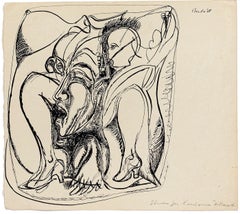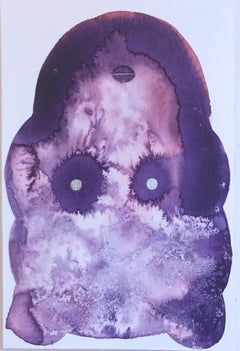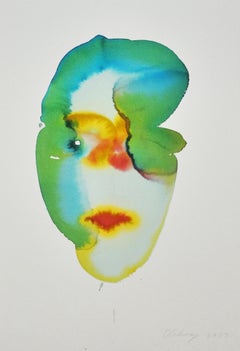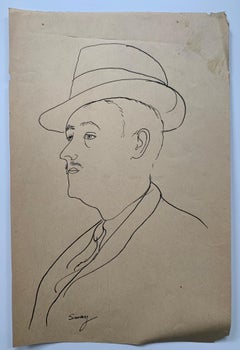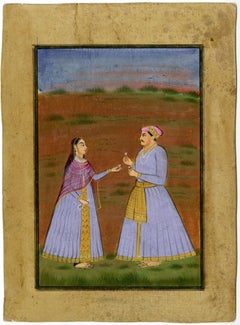Ornament Portrait Drawings and Watercolors
to
3
Overall Width
to
Overall Height
to
1
2
1
2
2
1
276
3,438
1,963
1,948
1,656
1,237
713
661
625
497
443
358
143
101
88
83
76
68
58
54
3
2
1
1
1
1
1
2
1
Art Subject: Ornament
Study for the Murder of Marat - China Ink Drawing - 1968
Located in Roma, IT
Study for the Murder of Marat (Studio per l'uccisione di Marat) is the original black ink and black marker drawing on paper, realized in 1968 by Gian Paolo Berto (Andria, Italy, 1940...
Category
1960s Synthetic Cubist Portrait Drawings and Watercolors
Materials
Ink
Venus of the Lilacs
Located in Jersey City, NJ
Venus of the Lilacs, 2020, watercolor, ink, mirror paint, and salt on Arches paper. Venus of Willendorf, fertility goddess, pink, purple, silver, a...
Category
2010s Contemporary Figurative Drawings and Watercolors
Materials
Paper, Ink, Watercolor
Head 02 - Contemporary Figurative Ink Painting, New Expressionism
Located in Salzburg, AT
The artwork on paper will be sent unframed to you.
Maciej Olekszy was born in 1982, Poland. Graduated from the Academy of Fine Arts in Poznan, Poland in 2007. Faculty of Painting i...
Category
2010s Contemporary Figurative Paintings
Materials
Paper, Ink
Related Items
Portrait of a Man drawing WPA era
Located in Wilton Manors, FL
Beautiful original drawing by American artist, Albert Sway (b.1913). Portrait of a young woman, ca. 1935. Signed lower right. Unframed. No damage or conservation.
Birth place: Cinc...
Category
1930s American Realist Portrait Drawings and Watercolors
Materials
Paper, Ink
Mughal School, 18th Century Emperor Jahangir with Empress Nur Jahan
Located in Middletown, NY
Emperor Jahangir and Empress Nur Jahan exchanging lotus blossoms; a symbol of beauty, purity, honesty, rebirth, self-regeneration, and enlightenment....
Category
18th Century Rajput Figurative Drawings and Watercolors
Materials
Gold
Hermes 1929
Located in Stockholm, SE
An interesting and highly decorative chalk drawing by Edvard Andersson, 1929. Drawn on a quite large scale. Signed and dated EA, 1929. A tergo written "Hermes".
The drawing is exec...
Category
1920s Cubist Abstract Drawings and Watercolors
Materials
Paper, Chalk
Drawing, pastel, ink and colored pencils. "Free spirits"
Located in Bogotá, Bogotá
Pastel, Pencil, petal flowers, Color and Ink on Paper.
The base of this drawing is Fabriano paper of 120g /m2. I use natural dyes of flowers, herbs, leaves, bark of trees as the fir...
Category
2010s Expressionist Portrait Drawings and Watercolors
Materials
Paper, Pastel, Ink, Pencil, Color Pencil
Neoclassical composition of a sculptor kneeling before his statue of the Madonna
Located in Middletown, NY
An allegory of loyalty, with the subject's dog pictured seated, holding his master's chisel in his mouth; fidelity personified.
Italian School, 18th century
Ink wash in gray and bl...
Category
Mid-18th Century Italian School Figurative Paintings
Materials
Laid Paper, Ink, Watercolor
Gibson Girls - Set of Two 1920's Portraits, Vintage Fashion Illustrations
Located in Soquel, CA
Gorgeous pair of two 1920's watercolor portraits of Gibson girls, one in blue and one in pink, by Charles Hollman (Dutch, 1877-1953). Each portrait renders...
Category
1920s American Impressionist Portrait Drawings and Watercolors
Materials
Paper, Watercolor
Rare Modernist Hungarian Rabbi Pastel Drawing Gouache Painting Judaica Art Deco
Located in Surfside, FL
Rabbi in the synagogue at prayer wearing tallit and tefillin.
Hugó Scheiber (born 29 September 1873 in Budapest – died there 7 March 1950) was a Hungarian modernist painter.
Hugo Scheiber was brought from Budapest to Vienna at the age of eight where his father worked as a sign painter for the Prater Theater. At fifteen, he returned with his family to Budapest and began working during the day to help support them and attending painting classes at the School of Design in the evening, where Henrik Papp was one of his teachers. He completed his studies in 1900. His work was at first in a post-Impressionistic style but from 1910 onward showed his increasing interest in German Expressionism and Futurism. This made it of little interest to the conservative Hungarian art establishment.
However, in 1915 he met the great Italian avant-gardist Filippo Tommaso Marinetti and the two painters became close friends. Marinetti invited him to join the Futurist Movement. The uniquely modernist style that he developed was, however, closer to German Expressionism than to Futurism and eventually drifted toward an international art deco manner similar to Erté's. In 1919, he and his friend Béla Kádar held an exhibition at the Hevesy Salon in Vienna. It was a great success and at last caused the Budapest Art Museum to acquire some of Scheiber's drawings. Encouraged, Scheiber came back to live in Vienna in 1920.
A turning point in Scheiber's career came a year later, when Herwarth Walden, founder of Germany's leading avant-garde periodical, Der Sturm, and of the Sturm Gallery in Berlin, became interested in Scheiber's work. Scheiber moved to Berlin in 1922, and his paintings soon appeared regularly in Walden's magazine and elsewhere. Exhibitions of his work followed in London, Rome, La Paz, and New York.
Scheiber's move to Germany coincided with a significant exodus of Hungarian artists to Berlin, including Laszlo Moholy-Nagy and Sandor Bortnyik. There had been a major split in ideology among the Hungarian avant-garde. The Constructivist and leader of the Hungarian avantgarde, Lajos Kassák (painted by Hugó Scheiber in 1930) believed that art should relate to all the needs of contemporary humankind. Thus he refused to compromise the purity of his style to reflect the demands of either the ruling class or socialists and communists. The other camp believed that an artist should be a figurehead for social and political change.
The fall out and factions that resulted from this politicisation resulted in most of the Hungarian avant gardists leaving Vienna for Berlin. Hungarian émigrés made up one of the largest minority groups in the German capital and the influx of their painters had a significant effect on Hungarian and international art. Another turning point of Scheiber's career came in 1926, with the New York exhibition of the Société Anonyme, organized by Katherine Dreier. Scheiber and other important avant garde artists from more than twenty-three countries were represented. In 1933, Scheiber was invited by Marinetti to participate in the great meeting of the Futurists held in Rome in late April 1933, Mostra Nazionale d’Arte Futurista where he was received with great enthusiasm. Gradually, the Hungarian artists began to return home, particularly with the rise of Nazism in Germany. Kádar went back from Berlin in about 1932 and Scheiber followed in 1934.
He was then at the peak of his powers and had a special flair in depicting café and cabaret life in vivid colors, sturdily abstracted forms and spontaneous brush strokes. Scheiber depicted cosmopolitan modern life using stylized shapes and expressive colors. His preferred subjects were cabaret and street scenes, jazz musicians, flappers, and a series of self-portraits (usually with a cigar). his principal media being gouache and oil. He was a member of the prestigious New Society of Artists (KUT—Képzőművészek Új Társasága)and seems to have weathered Hungary's post–World War II transition to state-communism without difficulty. He continued to be well regarded, eventually even receiving the posthumous honor of having one of his images used for a Russian Soviet postage stamp (see image above). Hugó Scheiber died in Budapest in 1950.
Paintings by Hugó Scheiber form part of permanent museum collections in Budapest (Hungarian National Museum), Pecs (Jannus Pannonius Museum), Vienna, New York, Bern and elsewhere. His work has also been shown in many important exhibitions, including:
"The Nell Walden Collection," Kunsthaus Zürich (1945)
"Collection of the Société Anonyme," Yale University Art Gallery, New Haven, Connecticut (1950)
"Hugó Scheiber: A Commemorative Exhibition," Hungarian National Museum, Budapest (1964)
"Ungarische Avantgarde," Galleria del Levante, Munich (1971)
"Paris-Berlin 1900-1930," Centre Georges Pompidou, Paris (1978)
"L’Art en Hongrie, 1905-1920," Musée d’Art et l’Industrie, Saint-Etienne (1980)
"Ungarische Avantgarde in der Weimarer Republik," Marburg (1986)
"Modernizmus," Eresz & Maklary Gallery, Budapest (2006)
"Hugó Scheiber & Béla Kádár," Galerie le Minotaure, Paris and Tel Aviv (2007)
Hugó Scheiber's paintings continue to be regularly sold at Sotheby's, Christie's, Gillen's Arts (London), Papillon Gallery (Los Angeles) and other auction houses.
He was included in the exhibition The Art Of Modern Hungary 1931 and other exhibitions along with Vilmos Novak Aba, Count Julius Batthyany, Pal Bor, Bela Buky, Denes Csanky, Istvan Csok, Bela Czobel, Peter Di Gabor, Bela Ivanyi Grunwald, Baron Ferenc Hatvany, Lipot Herman, Odon Marffy, C. Pal Molnar...
Category
Early 20th Century Modern Figurative Paintings
Materials
Paper, Charcoal, Pastel, Watercolor, Gouache
Early 20th Century Young Golfer Figurative
By Margaret Neilson
Located in Soquel, CA
Study of a young man with his golf clubs by listed artist Margaret Neilson Armstrong (American, 1867-1944). Image, 14"H x 20"W. Displayed in vintage mat. S...
Category
1920s Realist Portrait Drawings and Watercolors
Materials
Paper, Pencil
Rococo Portait, French Rococo, Marie Baudouin, Daughter of Francois Boucher
Located in Greven, DE
Portrait of the daughter of Francois Boucher, Marie-Emilie Baudouin, holding a basket of flowers. Pastel on Parchment. The work is related to an oval portrait painting...
Category
18th Century Rococo Portrait Drawings and Watercolors
Materials
Pastel
Jaider Portrait. Watercolor, Ink and Pastel on Archival Paper.
Located in Miami Beach, FL
Jaider by Celso Castro-Daza
One of a kind
Watercolor, ink, and paster on an archival paper
Sheet Size: 19.50 H x 13.75 W
2018
Unframed
Drawing on paper is his basic work tool, s...
Category
2010s Contemporary Portrait Drawings and Watercolors
Materials
Watercolor, Archival Paper, Pastel, Archival Ink
H 19.5 in W 13.75 in D 0.1 in
By Alessandro Michele for Valentino. From the Fashion series
Located in Miami Beach, FL
The artist has covered New York collections for over 16 years and has interviewed, as a journalist, several fashion designers and personalities for different publications. He loves t...
Category
21st Century and Contemporary Contemporary Figurative Drawings and Water...
Materials
Paper, Ink, Watercolor
H 15 in W 11 in D 0.1 in
Argentinian Tango, Mixed Media Abstract Expressionist
Located in Soquel, CA
Argentinian Tango, Mixed Media Abstract Expressionist
An abstract portrait in cool pastels accented in vibrant yellow and pink and lined in ink, by California-based artist, Ricardo de Silva (American). Paper size: 17.75"H x 12"W
From a collection of Ricardo de Silva's work and memorabilia. DeSilva was born in Brazil and grew up in Los Angeles. He was a gallery owner, first in Santa Barbara in the 1960's and 70's, then in San Jose in the 1980's. He was dedicated to promoting the work of talented upcoming artists, including Kogyo and Hasui Kiyochika, Robert Frame, Jim Stuckenberg, Alice Robertson Carr, Deborah Eve Alastra...
Category
21st Century and Contemporary Abstract Expressionist Abstract Drawings a...
Materials
Paper, Gouache, Ink, Watercolor
